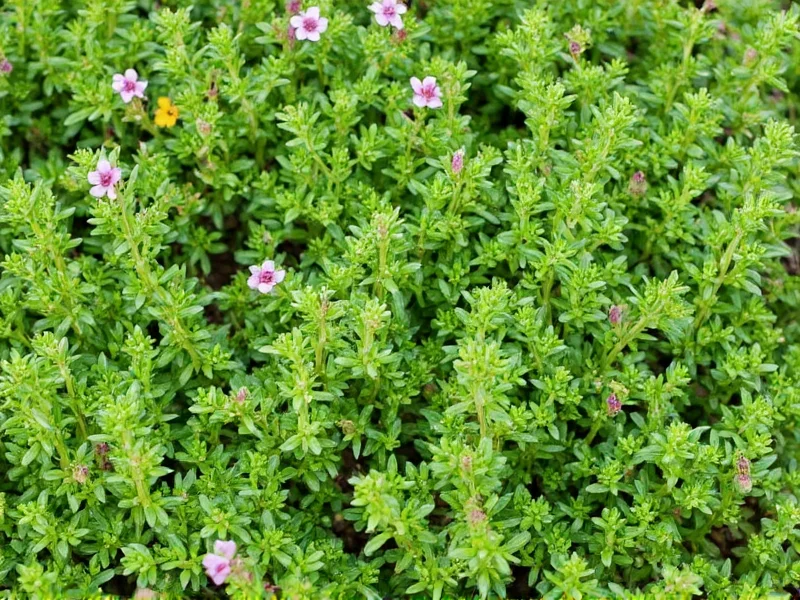Why Thyme Belongs in Every Garden
Thyme isn't just a kitchen staple—it's a garden workhorse that offers multiple benefits beyond flavoring your dishes. This low-growing perennial creates beautiful ground cover while repelling pests like cabbage worms and whiteflies. Its tiny flowers attract beneficial pollinators including bees and butterflies, enhancing your entire garden ecosystem. Unlike many herbs that require constant attention, thyme establishes deep roots that make it remarkably drought-tolerant once mature. Gardeners appreciate how this resilient herb maintains its aromatic foliage throughout summer heat and even survives light frosts in fall.
Top Thyme Varieties for Garden Success
Choosing the right thyme variety makes all the difference in garden performance. English thyme (Thymus vulgaris) remains the most versatile culinary option with its classic earthy flavor. For gardeners seeking visual interest, creeping thyme (Thymus serpyllum) forms dense mats perfect between stepping stones. Lemon thyme adds citrus notes to dishes while tolerating partial shade better than other varieties. Consider these top performers for your thyme garden:
| Variety | Height | Best Use | Cold Hardiness |
|---|---|---|---|
| English Thyme | 8-12 inches | Culinary, medicinal | Zone 5 |
| Lemon Thyme | 6-10 inches | Culinary, ornamental | Zone 6 |
| Creeping Thyme | 2-3 inches | Ground cover, pathways | Zone 4 |
| Woolly Thyme | 2-4 inches | Ornamental, rock gardens | Zone 5 |
Creating the Perfect Thyme Garden Environment
Thyme's Mediterranean origins dictate its ideal growing conditions. Your thyme garden requires at least six hours of direct sunlight daily—more in cooler climates. The soil must drain exceptionally well; amend heavy clay soils with coarse sand and compost to prevent root rot. Aim for a slightly alkaline pH between 6.0-8.0, which most garden soils naturally provide. Raised beds work exceptionally well for thyme gardens in regions with heavy rainfall. When establishing your thyme garden, remember that less is more: over-fertilizing produces weak, flavorless growth while proper thyme garden soil requirements emphasize lean conditions that concentrate essential oils.
Step-by-Step Thyme Garden Planting Guide
Plant thyme in your garden after the last spring frost when soil temperatures reach 70°F (21°C). Start with healthy nursery plants or propagate from cuttings taken in early summer. Dig holes twice as wide as the root ball but no deeper. Position plants with the crown level with the soil surface—burying it invites rot. Space English and lemon thyme 12-18 inches apart while creeping varieties need 8-12 inches between plants. Water thoroughly after planting, then allow the top inch of soil to dry before watering again. Mulch with gravel or crushed stone rather than organic materials to maintain dry conditions around the stems. For container thyme gardens, use terra cotta pots with drainage holes and a cactus/succulent potting mix.
Seasonal Thyme Garden Maintenance
Proper thyme garden care changes throughout the year. During spring growth, pinch back new shoots to encourage bushiness. Water established plants only when the top 2 inches of soil feel dry—typically once every 10-14 days in summer. Avoid overhead watering to prevent fungal issues. In midsummer, give your thyme garden a light trim to maintain shape and prevent woody growth. Fall brings the most important pruning: cut plants back by one-third after flowering to strengthen them for winter. In colder zones, apply a light mulch of straw after the first hard frost. Never fertilize thyme gardens—these plants thrive in nutrient-poor conditions that concentrate their essential oils and flavor compounds.
Troubleshooting Common Thyme Garden Problems
While thyme gardens generally face few issues, watch for these potential problems. Root rot from overwatering shows as yellowing leaves and mushy stems—immediately reduce watering and improve drainage. Powdery mildew appears as white spots on leaves during humid periods; increase air circulation and avoid wetting foliage. Aphids occasionally attack new growth; blast them off with water or use insecticidal soap. If your thyme garden becomes woody at the base, it needs more aggressive pruning—cut back to live green growth in spring. Poor flavor usually indicates too much nitrogen in the soil or insufficient sunlight. Remember that thyme naturally slows growth in extreme heat; don't mistake summer dormancy for plant death.
Companion Planting Strategies for Thyme Gardens
Thyme's pest-repelling properties make it an excellent companion plant throughout your garden. Plant thyme near brassicas like cabbage and broccoli to deter cabbage worms. Interplant with roses to prevent black spot and repel aphids. Grow thyme alongside strawberries to improve their flavor while deterring slugs. The strong scent masks the aroma of nearby vegetables from pests. Thyme pairs particularly well with other Mediterranean herbs including rosemary, sage, and oregano in herb garden arrangements. Avoid planting thyme near moisture-loving herbs like mint or cilantro, as their different water needs create conflicting garden conditions. For vegetable garden thyme placement, position it at the edges of beds where its spreading habit won't compete with root vegetables.
Harvesting and Preserving Your Thyme Garden Bounty
Harvest thyme in the morning after the dew dries but before the sun becomes intense, when essential oil concentrations peak. Never remove more than one-third of the plant at once. For fresh use, snip individual stems just above a leaf node. For drying, cut 4-6 inch stems in late morning when flowers begin to open. Bundle stems and hang upside down in a dark, well-ventilated space for 1-2 weeks. Alternatively, spread leaves on a baking sheet and dry in an oven at the lowest setting with the door slightly open. Store dried thyme in airtight containers away from light. Frozen thyme retains more flavor than dried—chop leaves and freeze in ice cube trays with olive oil. Properly harvested thyme garden yields can provide year-round flavor for cooking and medicinal uses.











 浙公网安备
33010002000092号
浙公网安备
33010002000092号 浙B2-20120091-4
浙B2-20120091-4